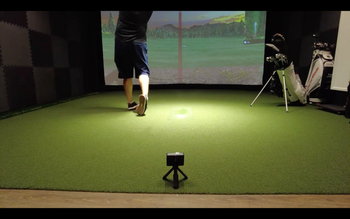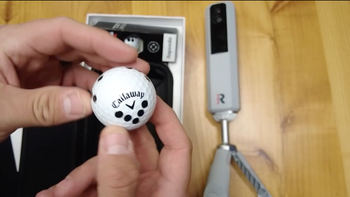You're standing 150 yards out, staring at a sprinkler head marked "135." You've got no clue if that's to the front, middle, or back of the green. Sound familiar? Yeah, we've all been there, pulling the wrong club and watching our ball sail over the green or come up short in a bunker.
Here's the thing - those old-school methods of figuring out distances are killing your scores. Walking off paces from markers? That's about as reliable as your buddy's "it's about a 7-iron" advice. Even GPS watches and apps can be off by 5-10 yards, and they won't tell you the distance to that bunker guarding the left side.
Enter the golf rangefinder - basically a point-and-shoot device that uses laser technology to nail down exact distances. You aim it at whatever you want (the flag, a tree behind the green, that water hazard you're desperately trying to avoid), press a button, and boom - you've got your number in under a second.
Here's where it gets really cool. Modern rangefinders don't just measure straight-line distance. They've got this thing called slope technology that figures out if you're hitting uphill or downhill. So when you're facing that elevated green that always tricks you, the rangefinder calculates the "plays like" distance. That 150-yard shot uphill? It might actually play like 165, and now you know to grab an extra club.
The accuracy is nuts - we're talking within a yard or two. Compare that to guesstimating from a 150-yard stake that could be 20 yards off to one side, and you'll see why tour pros won't play without their caddies having one.
You'll notice the difference right away. Instead of standing over your ball wondering if it's a hard 8-iron or a smooth 7, you'll know it's exactly 147 yards and pull the right stick with confidence. That confidence translates to better swings and better results. Plus, you'll play faster since you're not wandering around looking for yardage markers or waiting for your GPS to update.
Now, let's keep it real - rangefinders aren't magic wands. They won't fix your slice or help you read greens. In heavy fog or rain, they can struggle to lock onto targets. Unlike GPS devices, they can't show you the shape of a dogleg or hidden hazards you can't see. Some courses with tons of elevation changes might make it tough to get a reading on the flag if it's way above or below you.
The learning curve is pretty minimal, though. After a round or two, using one becomes second nature. Most models have different modes - one for regular play and one for tournament play (where slope-reading isn't allowed). The good ones vibrate or beep when they lock onto the flag, so you know you're not accidentally measuring the trees behind the green.
For your typical weekend warrior shooting in the 80s or 90s, a rangefinder can easily save you 3-5 strokes per round just by eliminating the distance guessing game. Think about how many times you've come up short because you underclubbed, or airmailed a green because you didn't account for that downslope. Those mistakes add up fast.
If you're serious about dropping your scores and you're tired of the distance guessing game, a rangefinder is one of the best investments you can make. It won't break the bank like a new driver, but it'll help you way more often - you use it on virtually every shot except putts. Once you start pulling the right club every time and watching your approaches land pin-high, you'll wonder how you ever played without one.
Discover the Purpose of a Golf Rangefinder

You know that feeling when you're standing 150 yards out and can't decide between your 7-iron and 8-iron? A golf rangefinder kills that doubt instantly. It's basically a high-tech distance measurer that shoots a laser at whatever you're aiming at - the flag, that oak tree behind the green, or even the water hazard you're desperately trying to avoid.
You point it at your target, press a button, and boom - you've got your exact distance in under a second. The thing fires an invisible laser beam that bounces off your target and comes back, and the device calculates how far away you are based on how long that round trip took. Pretty slick, right?
What really changes the game is when your rangefinder has slope technology. Let's say you're hitting to an elevated green that's 150 yards away. Without slope, you'd club up wrong and come up short. With slope turned on, it'll tell you the shot actually plays like 165 yards because of the uphill angle. Just remember - you gotta switch off that slope feature during official tournaments since it's not allowed in competitive play.
The latest models are getting seriously fancy. If you've got shaky hands after too much coffee (or last night's nineteenth hole), some rangefinders now have built-in stabilization to lock onto your target easier. There are even models connecting to your launch monitor data, basically becoming your personal caddie that knows exactly how far you hit each club.
One trick I love is the triangulation feature on newer units. You can zap two different spots - like the front and back of a green - and it'll tell you how deep that green is. Super helpful when you're trying to avoid those back bunkers.
Here's the thing, though - while rangefinders are awesome for dialing in distances, they won't fix a bad swing or read the greens for you. And yeah, the really good ones with all the bells and whistles can set you back $400-600. But if you're tired of coming up short on approach shots or flying greens because you guessed wrong, it's money well spent.
The confidence boost alone is worth it. Instead of standing over your ball wondering if you've got enough club, you'll know exactly what you need. That mental clarity translates to better swings and lower scores. Plus, the pace of play improves when you're not walking off yardages or hunting for sprinkler heads.
Rangefinder vs GPS Devices – Which Elevates Your Game?
You know how we're always debating whether to get a rangefinder or just stick with those GPS watches everyone's wearing? Well, here's the deal - they're totally different animals.
Your GPS watch or handheld is like having a caddie who gives you the general lay of the land. You'll get distances to the front, center, and back of the green, plus where all the trouble spots are hiding. It's quick, it's easy, and you don't have to stop and aim at anything. Just glance down and boom - you've got your numbers.
But here's where rangefinders shine - they're like having a laser-guided missile for your distance control. You point that baby at the exact spot you want to hit, whether it's the flag, that tree you're trying to carry, or the bunker you definitely want to avoid. And it'll tell you within a yard - sometimes even closer - exactly how far you've got.
Sure, GPS tech keeps getting fancier with all sorts of bells and whistles. But when push comes to shove, nothing beats knowing you've got 147.5 yards to that back pin, not just "somewhere between 145 and 155" like your GPS might tell you.
So if you're the type who wants to dial in your distances and really nail down which club to pull, a rangefinder's gonna be your new best friend. Yeah, it takes an extra second or two to zap your target, but when you're standing over that approach shot, you'll have way more confidence knowing exactly what you're dealing with.
Trust me, once you start hitting your 7-iron to the exact number instead of guessing between clubs, you'll wonder how you ever played without one. Now let's dive into why you need to make room in your bag for one of these bad boys.
12 Compelling Advantages of Owning a Golf Laser Rangefinder

1. You know that feeling when you're standing over your ball, squinting at the 150-yard marker, wondering if it's actually 145 or maybe 155? Yeah, rangefinders put an end to that nonsense. Just aim at your target, press a button, and boom - you've got your exact distance down to the decimal point. No more walking off yardages or trusting those beat-up markers that groundskeepers haven't updated since the Clinton administration.
2. The speed on these things is ridiculous. We're talking lightning-fast readings - under a second in most cases. Point it at the flag, click, and you've got measurements so precise they'll tell you if you're 147.3 yards out. That's the kind of accuracy that turns your 7-iron versus 8-iron debate into a no-brainer.
3. Here's where it gets really cool - slope technology. This feature basically does the thinking for you when you're hitting uphill or downhill. Let's say you're 150 yards from the pin, but it's elevated 20 feet above you. The rangefinder calculates that elevation change and tells you it's playing more like 165 yards. It's basically doing caddie-level calculations without you having to slip anyone a twenty.
4. The hybrid models? Man, these are next-level. They combine laser accuracy with GPS mapping, so you're covered whether you can see the flag or it's hidden behind that massive oak tree on the dogleg. When you can't get a direct line of sight, the GPS kicks in and shows you distances to the front, middle, and back of the green.
5. Ever stood on the tee wondering if you can carry that water hazard? These devices have a scan mode that lets you sweep across the entire hole. You'll know it's 210 to clear the water, 185 to that fairway bunker, and 230 to reach those trees. No more "I think I can make it" moments that end with you fishing balls out of the drink.
6. Talk about keeping things moving - rangefinders are pace-of-play heroes. While your playing partners are wandering around looking for sprinkler heads, you're already pulling your club and setting up for the shot. The whole group benefits when everyone's ready to play instead of doing yardage math.
7. Here's the bottom line on scoring: when you know your exact distance, you pick the right club. When you pick the right club, you hit more greens. When you hit more greens, those triple bogeys turn into pars. Plus, there's something about having that precise number that makes you commit to the shot instead of making a wishy-washy swing.
8. Course management becomes a whole different game. You're not just shooting flags anymore - you're picking specific landing zones. Want to leave yourself 90 yards instead of some awkward half-wedge distance? Zap that spot and play to it. It's chess instead of checkers out there.
9. These things are smaller than you'd think. Most slip right into your pocket without creating that awkward bulge that messes with your swing. Lots of them come with magnetic strips so they stick right to your cart frame. Some are so compact you'll forget you're carrying them until you need 'em.
10. Good news for you competitive types - they're legal in most amateur tournaments now. Just make sure you can turn off the slope feature when you're playing for money or trophies. Most models have an indicator light or display that shows when slope is disabled, so there's no question about playing by the rules.
11. Look, we all love our gadgets, and rangefinders are genuinely fun to use. The newer ones have image stabilization for those of us with coffee jitters, and some even sync with weather apps and your personal club distances. It's like having a tiny golf computer that actually makes the game more enjoyable instead of complicated.
12. At the end of the day, golf's better when you're playing well and not holding up the group behind you. Rangefinders nail both of those things. They help you shoot lower scores by taking the guesswork out of distance, and they keep everyone moving because you're not hunting for yardage markers. Plus, let's be honest - pulling out that rangefinder and zapping the flag just feels pretty darn cool.
Frequently Asked Questions
How does a golf laser rangefinder improve accuracy on the course?
A golf laser rangefinder provides precise yardages to the flag, hazards, or any visible target, eliminating guesswork and enabling you to make more accurate shots. This leads to better club selection and improved consistency in your game.
Can using a rangefinder help lower my golf scores?
Yes, by giving you exact distances and helping you make smarter decisions, a rangefinder can help you hit more greens in regulation and avoid costly mistakes, ultimately lowering your scores.
Will a rangefinder speed up my pace of play?
Absolutely. With instant distance readings, you spend less time estimating yardages or searching for markers, resulting in quicker decisions and a faster, more enjoyable round.
How does a rangefinder assist with club selection?
Knowing the exact distance to your target allows you to confidently choose the right club for each shot, reducing uncertainty and improving your shot outcomes.
Are rangefinders useful for more than just measuring to the flag?
Yes, laser rangefinders can measure distances to bunkers, water hazards, trees, doglegs, and other course features, making them versatile tools for strategic course management.





